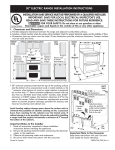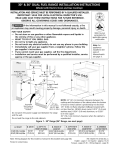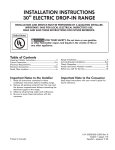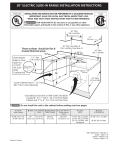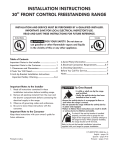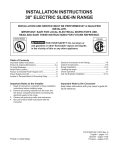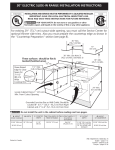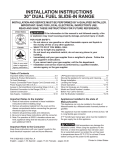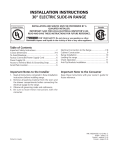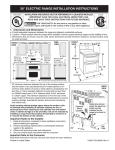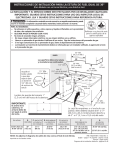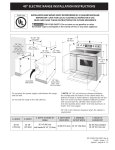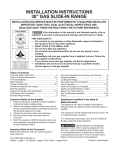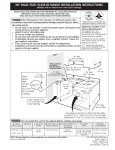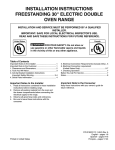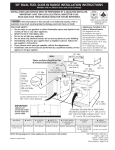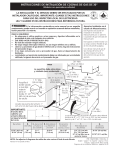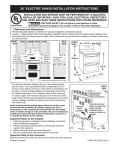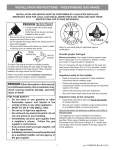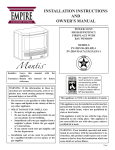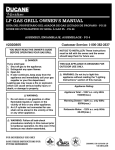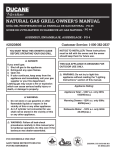Download Kenmore Elite 30'' Double-Oven Slide-In Electric Range w/ Convection - Black Installation Guide
Transcript
INSTALLATION INSTRUCTIONS 30" ELECTRIC SLIDE-IN RANGE United States INSTALLATION AND SERVICE MUST BE PERFORMED BY A QUALIFIED INSTALLER. IMPORTANT: SAVE FOR LOCAL ELECTRICAL INSPECTOR'S USE. READ AND SAVE THESE INSTRUCTIONS FOR FUTURE REFERENCE. FOR YOUR SAFETY: Do not store or use gasoline or other flammable vapors and liquids in the vicinity of this or any other appliance. Table of Contents Important Safety Instructions .........................................2 Product Dimensions .........................................................3 Cutout Dimensions ...........................................................4 To Avoid Breakage...........................................................5 Power Supply Kit..............................................................6 Access to Terminal Block & Grounding Strap .............6 Serial Plate Location .......................................................6 Electrical Connection to the Range ..........................7-8 Cabinet Construction .......................................................9 Range Installation .......................................................... 10 Leveling the range ......................................................... 10 Decorative Rear Trim Installation (if required) ........... 11 Check Operation ............................................................ 11 Anti-Tip Brackets Installation ....................................... 12 Important Notes to the Installer Important Note to the Consumer 1. Read all instructions contained in these installation instructions before installing range. 2. Remove all packing material from the oven and the drawer compartments before connecting the electrical supply to the range. 3. Observe all governing codes and ordinances. 4. Be sure to leave these instructions with the consumer. Printed in Canada Keep these instructions with your owner's guide for future reference. P/N 318201629 (1205) Rev. A English – pages 1-12 Español – páginas 13-24 30" ELECTRIC SLIDE-IN RANGE INSTALLATION INSTRUCTIONS IMPORTANT SAFETY INSTRUCTIONS This manual contains important safety symbols and instructions. Please pay attention to these symbols and follow all instructions given. This symbol will help alert you to situations that may cause serious bodily harm, death or property damage. This symbol will help alert you to situations that may cause bodily injury or property damage. • Be sure your range is installed and grounded properly by a qualified installer or service technician. • This range must be electrically grounded in accordance with local codes or, in their absence, with the National Electrical Code ANSI/NFPA No. 70—latest edition. • The installation of appliances designed for manufactured (mobile) home installation must conform with Manufactured Home Construction and Safety Standard, title 24CFR, part 3280 [Formerly the Federal Standard for Mobile Home Construction and Safety, title 24, HUD (part 280)] or when such standard is not applicable, the Standard for Manufactured Home Installation 1982 (Manufactured Home Sites, Communities and Setups), ANSI Z225.1/ NFPA 501A-latest edition, or with local codes. • Make sure the wall coverings around the range can withstand the heat generated by the range. • Before installing the range in an area covered with linoleum or any other synthetic floor covering, make sure the floor covering can withstand heat at least 90°F above room temperature without shrinking, warping or discoloring. Do not install the range over carpeting unless you place an insulating pad or sheet of 1/4" thick plywood between the range and carpeting. Never leave children alone or unattended in the area where an appliance is in use. As children grow, teach them the proper, safe use of all appliances. Never leave the oven door open when the range is unattended. Stepping, leaning or sitting on the door or drawer of this range can result in serious injuries and can also cause damage to the range. • Do not store items of interest to children in the cabinets above the range. Children could be seriously burned climbing on the range to reach items. • To eliminate the risk of burns or fire by reaching over heated surface units, cabinet storage space above the surface unit should be avoided. If cabinet storage is to be provided the risk can be reduce by installing a range • • • • hood that project horizontally a minimum of 5 inches beyond the bottom of the cabinet. Do not use the oven as a storage space. This creates a potentially hazardous situation. Never use your range for warming or heating the room. Prolonged use of the range without adequate ventilation can be dangerous. D o n o t s t o re o r u s e g a s o l i n e o r o t h e r flammable vapors and liquids near this or any other appliance. Explosions or fires could result. Reset all controls to the "off " position after using a programmable timing operation. FOR MODELS WITH SELF-CLEAN FEATURE: • Remove broiler pan, food and other utensils before self-cleaning the oven. Wipe up excess spillage. Follow the pre-cleaning instructions in the Use and Care Guide. Tip Over Hazard • A child or adult can tip the range and be killed. • Verify the anti-tip device has been installed to floor or wall as per installation instructions. • Ensure the anti-tip device is re-engaged to floor or wall when the range is moved. • Do not operate the range without the anti-tip device in place and engaged. • Failure to follow these instructions can result in death or serious burns to children and adults. To check if the anti-tip bracket is installed properly, use both arms and grasp the rear edge of range back. Carefully attempt to tilt range forward. When properly installed, the range should not tilt forward. Refer to the anti-tip bracket installation instructions supplied with your range for proper installation. 2 30" ELECTRIC SLIDE-IN RANGE INSTALLATION INSTRUCTIONS Product Dimensions E D Do not install the unit in the cabinet before reading next two pages. C en Op e 5) r o Do e not (se A B A. HEIGHT (Under Cooktop) B. WIDTH Min: 35 7/8" (91.1 cm) 30" (76,2 cm) Max: 36 5/8" (93 cm) Side Panel C. COOKTOP WIDTH 31 5/16" (79.5 cm) With Trim : 31 7/16" (79.9 cm) D. TOTAL DEPTH TO FRONT OF RANGE 29 1/4" (74,3 cm) E. COOKTOP DEPTH 20 9/16" (52.2 cm) With Trim : 22 9/16" (57.3 cm) Notes 1 Do not pinch the power supply cord between the range and the wall. 2 Do not seal the range to the side cabinets. 3 Allow a 24" (61 cm) minimum clearance between the cooktop and the bottom of the 4 5 cabinet when the bottom of wood or metal cabinet is protected by not less than 1/4" (0.64 cm) flame retardant millboard covered with not less than No. 28 MSG sheet metal, 0.015" (0.4 mm) stainless steel, 0.024" (0.6 mm) aluminum, or 0.020" (0.5 mm) copper. Allow a 30" (76.2 cm) minimum clearance when the cabinet is unprotected. For cutouts below 22 7/8"(58.1 cm), appliance will slightly show out of the cabinet. Allow at least 14 ¼" (36.2 cm) clearance for door depth when it is open. 3 30" ELECTRIC SLIDE-IN RANGE INSTALLATION INSTRUCTIONS Cutout Dimensions 30" Min. (76.2 cm) Min. 13" (33 cm) These surfaces should be flat & leveled (hatched area). 30" Min. (see Note 3) (76.2 cm) Min. (See Note 3) ½”min. 18" Min. (45.7 cm) Min. ¼”min. Shave Raised Edge To Clear Space for 31 5/16" (81cm) Wide Cooktop Rim. 1 ½" Max. (3.8 cm Max.) F H ½”min. Approx. 1 7/8" (4.8 cm) 24" Min. (61 cm) Min. G Locate Cabinet Doors or Drawers 1¼" (3.2 cm) Min. From Surface of Countertop Grounded Junction Box or Wall Outlet Should Be Located 4" (10.2 cm) From Right or Left Cabinet Wall and 2" to 4" (5.1-10.2 cm) From Floor F. CUTOUT WIDTH*** (Countertop and cabinet) 30±1/16" (76,2±0,15 cm) G. CUTOUT DEPTH 21 5/8" (54,9 cm) Min. 22 1/8" (56,2 cm) Max 24" (61 cm) Min. with backguard H. HEIGHT OF COUNTERTOP 36 5/8" (93 cm) Max. 35 7/8" (91.1 cm) Min. ***IMPORTANT: To avoid cooktop breakage for cutout width (F dimension) of more than 30 1/16" (76,4 cm), make sure the appliance is centered in the counter opening while pushing into it. Raise leveling legs at a higher position than the cabinet height (see page 5), insert the appliance in the counter and then level. Make sure the unit is supported by the leveling legs and NOT by the cooktop itself. F 22 3/4" (57.8 cm) min. 23 1/4" (59.05 cm) max. (see Note 4 on previous page) F 1 1/8" (2.86 cm) FRONT OF CABINET IMPORTANT: Cabinet and countertop width should match the cutout width. 4 GRef. 30" ELECTRIC SLIDE-IN RANGE INSTALLATION INSTRUCTIONS To avoid breakage: Do NOT handle or manipulate the unit by the cooktop glass. 1 2 3 4 5 6 7 The counter-top around the cut-out should be flat and leveled (see cross-hatched area in illustration 1). Before installing the unit, measure the heights of the two (2) cabinet sides (H1-4), front and back (see illustration 1) from the floor to the top of the counter. Level the range using the 1 ½" Max. (3.8 cm Max.) four (4) leveling legs so Shave that the height from the H2 H4 floor to the underside of Raised H1 Edge the cooktop glass frame to Clear is greater than the tallest Space for a H3 31 5/16" (79.5 cm) cabinet measurement Wide Cooktop. by at least 1/16" (see illustration 2). Slide the unit into the cabinet. Make sure the center of Illustration 1 the unit is aligned with the center of the cabinet cut-out. Remove the protective channels on each side of the glass cooktop (if provided). The metal flange under each side of the cooktop MUST be placed over the cabinet countertop for proper unit support. ge The glass cooktop should NOT directly touch the countertop Flan l a t Me (see illustration 2) or could cause glass breakage voiding the warranty. Level the unit if needed. After the installation, MAKE SURE that the unit is supported by the leveling legs NOT by the cooktop. 5 To successfully install the range, the initial level height from floor to underside of cooktop glass frame should be at least 1/16" taller than cabinet sides as measured in step 1. Illustration 2 30" ELECTRIC SLIDE-IN RANGE INSTALLATION INSTRUCTIONS 1 Power Supply Cord Kit 2 Access to Terminal Block & Grounding Strap The user is responsible for connecting the power supply cord to the connection block located behind the back panel access cover. This appliance may be connected by means of permanent "hard wiring"; flexible armored or nonmetallic shielded copper cable (when local code allow it) or by means of a power supply cord kit. Open terminal cover door NOTE: Electric Slide-in Range is shipped from factory with 1 1/8" (2.9 cm) dia. hole as shown on figure 4. If a larger hole is required, punch out the knockout. Figure 1 This appliance is manufactured with the frame grounded by connection of a grounding strap between the neutral power supply terminal and the frame. If used in USA, in a new branch circuit installation (1996 NEC), mobile home or recreational vehicule, where local code do not permit grounding through neutral (white) wire or in Canada; remove the grounding strap from the frame and cut the other end, near the neutral terminal. Connect the appliance in usual manner. Risk of fire or electrical shock exists if an incorrect size range cord kit is used, the Installation Instructions are not followed, or the strain relief bracket is discarded. For mobile homes, new installations or recreational vehicles, use only a power supply kit designed for a range at 125V/250V 50A recommended (minimum 40A). Cord must have either 3 (when local code permits grounding through neutral) or 4 conductors. Terminal on end of wires must be either closed loop or open spade lug with upturned ends. Cord must have strain-relief clamp. Electrical Shock Hazard • Electrical ground is required on this appliance. • Do not connect to the electrical supply until appliance is permanently grounded. • Disconnect power to the circuit breaker or fuse box before making the electrical connection. • T h i s a p p l i a n ce m u s t b e co n n e c t e d t o a grounded, metallic, permanent wiring system, or a grounding connector should be connected to the grounding terminal or wire lead on the appliance. Failure to do any of the above could result in a fire, personal injury or electrical shock. Do not loosen the nuts which secure the factory-installed range wiring to terminal block while connecting range. Electrical failure or loss of electrical connection may occur. Serial Plate Location You will find the model and serial number printed on the serial plate. The serial plate is located as shown. Remember to record the serial number for future reference. 6 Figure 2 30" ELECTRIC SLIDE-IN RANGE INSTALLATION INSTRUCTIONS Four Conductor Wire Connection to Range 3 Electrical Connection to the Range Where local codes does NOT permit connection of the frame grounding conductor to the neutral wire of the copper power supply cord (see Fig. 4) 1. Remove the 3 screws at the lower end of the rear wire cover, then raise the lower end of the rear wire cover (access cover) upward to expose range terminal connection block (see Fig. 2). 2. Remove the ground strap from the terminal block and from the appliance frame. 3. Using the nuts supplied in the literature package, connect the ground wire (green) of copper power supply cord to the frame of the appliance with the ground screw, using the hole in the frame where the ground strap was removed (see Fig. 4). 4. Connect the neutral of the copper power supply cord to the center silver-colored terminal of the terminal block, and connect the other wires to the outer terminals. Match wires and terminals by color (red wires connected to the right terminal, black wires connected to the left terminal). 5.Lower the terminal cover and replace the 3 screws. This appliance is manufactured with the neutral terminal connected to the frame. Three Conductor Wire Connection to Range If local codes permit connection of the frame grounding conductor to the neutral wire of the copper power supply cord (see Fig. 3): 1. Remove the 3 screws at the lower end of the rear wire cover, then bend the lower end of the rear wire cover (access cover) upward to expose range terminal connection block (see Fig. 2). 2. Using the nuts supplied in the literature package, connect the neutral of copper power supply cord to the center silver-colored terminal of the terminal block, and connect the other wires to the outer terminals. Match wires and terminals by color (red wires connected to the right terminal, black wires connected to the left terminal) (see Fig. 3). 3. Lower the terminal cover and replace the 3 screws. Silver colored Terminal Terminal Block Silver Colored Terminal Red wire Red Wire M C ou or P nt d la in te g Terminal Block White Wire (Neutral) Grounding Strap Black wire A strainrelief supplied by the user must be installed at this location Black wire 1-1/8“ Dia. Direct Connection Hole. Punch out knockout for 1-3/8“ Dia. Cord Kit Hole To 240 V receptacle White Wire (Neutral) Ground (Bare Copper or Green Wire) A strainrelief supplied by the user must be installed at this location 1-1/8“ Dia. Direct Connection Hole. Punch out knockout for 1-3/8“ Dia. Cord Kit Hole To 240 V receptacle NOTE: Be sure to remove the supplied grounding strap Figure 4 Figure 3 7 30" ELECTRIC SLIDE-IN RANGE INSTALLATION INSTRUCTIONS Direct Electrical Connection to the Circuit Breaker, Fuse Box or Junction Box Where local codes DO NOT permit connecting the appliance-grounding conductor to the neutral (white) wire, or if connecting to 4-wire electrical system (see Figure 6): If the appliance is connected directly to the circuit breaker, fuse box or junction box, use flexible, armored or nonmetallic sheathed copper cable (with grounding wire). Supply a U.L. listed strainrelief at each end of the cable. At the appliance end, the cable goes through the Direct Connection Hole (see Figure 4) on the Cord Mounting Plate. Wire sizes (copper wire only) and connections must conform to the rating of the appliance. 1. Be sure that no power is supplied on the cable from residence. 2. Remove the grounding strap from the terminal block and from the appliance frame. 3. In the circuit breaker, fuse box or junction box: A) Connect the white appliance cable wire to the neutral (white) wire. B) Connect the 2 black wires together. C) Connect the 2 red wires together. D) Connect the green (or bare copper) grounding wire to the grounding wire of the circuit breaker, fuse box or junction box. Where local codes permit connecting the appliance-grounding conductor to the neutral (white) wire (see Figure 5): 1. Be sure that no power is supplied on the cable from residence. 2. Remove the grounding strap from the terminal block and from the appliance frame. 3. In the circuit breaker, fuse box or junction box: A) Connect the green (or bare copper) wire, the white appliance cable wire, and the neutral (white) wire together. B) Connect the 2 black wires together. C) Connect the 2 red wires together. Figure 6 – 4-Wire Electrical System (Example: Junction Box) Figure 5 3-Wire (Grounded Neutral) Electrical System (Example: Junction Box) 8 30" ELECTRIC SLIDE-IN RANGE INSTALLATION INSTRUCTIONS 4 IMPORTANT Cabinet Construction Installation With Backguard A backguard kit can be ordered through a Sears Service Center.The cutout depth (21 5/8" (54.9 cm) Min., 22 1/8" (56.2 cm) Max.) needs to be increased to 24" (61 cm) when installing a backguard 4.1 To eliminate the risk of burns or fire by reaching over heated surface units, do not have cabinet storage space above the range. If there is cabinet storage space above range, reduce risk by installing a range hood that projects horizontally a minimum of 5" (12.7 cm) beyond the bottom of the cabinet. Installation With End Panel An end panel kit can be ordered through a Sears Service Center. 4.2 • • • • Countertop Preparation The cooktop sides of the range fit over the cutout edge of your countertop. If you have a square finish (flat) countertop, no countertop preparation is required. Cooktop sides lay directly on edge of countertop. Formed front-edged countertops must have molded edge shaved flat 3/4" (1.9 cm) from each front corner of opening (Fig. 7). Tile countertops may need trim cut back 3/4"(1.9 cm) from each front corner and/or rounded edge flattened (Figure 7). Min. Cutout Width Installation With Side Panel A side panels kit can be ordered through a Sears Service Center. Install cabinet doors 31" (78.7 cm) min. apart so as not to interfere with range door opening. ¾” (1.9 cm) 31 5/16” (79.5 cm) ¾” (1.9 cm) If Accessories Needed : Formed or tile countertop trimmed ¾" (1.9 cm) back at front corners of countertop opening. Figure 7 • If the existing cutout width is greater than 30 1/16" (76,4 cm), reduce the ¾" (1.9 cm) dimension. • Countertop must be level. Place a level on the countertop, first side to side, then front to back. If the countertop is not level, the range will not be level. The oven must be level for satisfactory baking results. Cooktop sides of range fit over edges of countertop opening. 9 30" ELECTRIC SLIDE-IN RANGE INSTALLATION INSTRUCTIONS 5 5.11 Level the range (see section 6). The floor where the range is to be installed must be level. Follow the instructions under "Leveling the RangeModels Equipped with Leveling Legs". Range Installation Important Note: Door removal is not a requirement for installation of the range, but is an added convenience. 5.12 Refer to the Use and Care Guide for oven door removal instructions. 6 Slide the range into the cutout opening. Leveling the range Models Equipped with Leveling Legs Level the range and set cooktop height before installation in the cut-out opening. 1. Install an oven rack in the center of the oven. 2. Place a level on the rack (see Figure 9). Take 2 readings with the level placed diagonally in one direction and then the other. Level the range, if necessary, by adjusting the 4 leg levelers with a wrench (see Figure 10). 3. Taking care to not damage the countertop, slide range into cutout opening and double check for levelness. Figure 8 Standard Installation 5.1 The range cooktop overlaps the countertop at the sides and the range rests on the floor. The cooktop is 31½" (81 cm) wide. 5.2 Install base cabinets 30" (76.2 cm) apart. Make sure they are plumb and level before attaching cooktop. Shave raised countertop edge to clear 31½" (81 cm) wide range top rim. 5.3 Install cabinet doors 31" (78.7 cm) min. apart so it will not interfere with range door opening. 5.4 Cutout countertop exactly as shown on page 4. 5.5 Make sure the four leveling legs (front and rear) are setup higher than the height of the cabinet (shown on page 5). 5.6 Install the anti-tip bracket at this point before placing the range at its final position. Follow the installation instructions on page 12 or on the anti-tip bracket template supplied with the range. Figure 9 5.7 To provide an optimum installation, the top surface of the countertop must be level and flat (lie on the same plane) around the 3 sides that are adjacent to range cooktop. Proper adjustments to make the top flat should be made or gaps between the countertop and the range cooktop may occur. 5.8 To reduce the risk of damaging your appliance, do not handle or manipulate it by the ceramic glass. Manipulate with care. Leg Leveler Raise 5.9 Position range in front of the cabinet opening. Lower 5.10 Make sure that the glass which overhangs the countertop clears the countertop. If necessary, raise the unit by lowering the leveling legs. Figure 10 10 30" ELECTRIC SLIDE-IN RANGE INSTALLATION INSTRUCTIONS 7 Decorative Rear Trim Installation (if required) 1. 2. 3. 4. 5. 6. 7. 8. 9. 8.2 Operation of Oven Elements The oven is equipped with an electronic oven control. Each of the functions has been factory checked before shipping. However, it is suggested that you verify the operation of the electronic oven controls once more. Refer to the Use & Care Guide for operation. Follow the instructions for the Clock, Timer, Bake, Broil, Convection (some models) and Clean functions. Bake–After setting the oven to 350°F (177°C) for baking, the lower element in the oven should become red. Broil–When the oven is set to BROIL, the upper element in the oven should become red. Clean–When the oven is set for a self-cleaning cycle, the upper element should become red during the preheat portion of the cycle. After reaching the self-cleaning temperature, the lower element will become red. Convection (some models)–When the oven is set to CONV. BAKE/ROAST at 350°F (177°C), the convection element cycles on and off and the convection fan turns. The convection fan will stop turning when the oven door is opened during convection baking or roasting. Disconnect the power from the range. Make sure the range is leveled. Pull range toward you. Take the distance between the floor and the surface underneath the cooktop frame. Mark that distance on the wall where the decorative trim will be installed. Draw a line. Place the top of the decorative trim under that line. Using the screws provided fix the decorative trim into the wall. Slide the range back into position and reconnect the power source (the bottom of the cooktop should be located over the decorative trim). Decorative Trim Scre w (3 ) Distance between the floor and the surface underneath the cooktop frame. When Power Connection is Completed Make sure all controls are left in the OFF position. Model and Serial Number Location The serial plate is located on the oven front frame behind the oven door (some models) or behind the drawer (some models). Figure 11 8 When ordering parts for or making inquiries about your range, always be sure to include the model and serial numbers and a lot number or letter from the serial plate on your range. Check Operation Refer to the Use and Care Guide packaged with the range for operating instructions and for care and cleaning of your range. Before You Call for Service Read the Before You Call for Service Checklist and operating instructions in your Use & Care Guide. It may save you time and expense. The list includes common occurrences that are not the result of defective workmanship or materials in this appliance. Refer to your Use & Care Guide for Sears service phone numbers, or call 1-800-4-MY-HOME®. Do not touch the elements. They may be hot enough to cause burns. Remove all packaging from the oven and the warmer drawer (if equipped) before testing. 8.1 Operation of Surface Elements Turn on each of the four surface elements and check to see that they heat. Check the surface element indicator light(s), if equipped. 11 30" ELECTRIC SLIDE-IN RANGE INSTALLATION INSTRUCTIONS 9 C. Level and position the range - Slide range to its final position. Insert the range leveling leg in the antitip bracket. Visually verify if the anti-tip bracket is engaged. Lower the range by adjusting the 4 leveling legs alternatively until the range is level. Check if the range is level by placing a spirit level on the oven rack. Take 2 readings with the spirit level placed diagonally; take a reading in one direction and then in the other direction. Level the range if necessary by adjusting the leveling legs. Anti-Tip Bracket Installation To reduce the risk of tipping of the range, the range must be secured to the floor by the properly installed anti-tip bracket and screws packed with the range. Failure to install the anti-tip bracket will allow the range to tip over if excessive weight is placed on an open door or if child climbs upon it. Serious injury might result from spilled hot liquids or from the range itself. If range is ever moved to a different location, the anti-tip bracket must also be moved and installed with the range. Instructions are provided for installation in wood or cement floor. When fastening to floor, be sure that screws do not penetrate electrical wiring or plumbing. A. Locate the Bracket Using the Template - Locate the bracket position (right or left side) by placing the template symmetrically to the center of the final range position. Mark the location of the screw holes, shown on template. Range side Figure 14 Leg Leveler Figure 12 Leveling leg Rear of Range B. Drill Pilot Holes and Fasten Bracket - Drill a 1/8" pilot hole where screws are to be located. If bracket is to be mounted to the wall, drill pilot hole at an approximate 20° downward angle. If bracket is to be mounted to masonry or ceramic floors, drill a 3/16" pilot hole 1-3/4" deep. The screws provided may be used in wood or concrete material. Use a 5/16" nut-driver or flat head screwdriver to secure the bracket in place. FASTEN BRACKET (WALL OR FLOOR MOUNTING) Raise Lower Figure 15 Wall mount Wall Plate Floor Mount Anti-Tip Bracket Figure 16 Figure 13 12 INSTRUCCIONES DE INSTALACIÓN ESTUFA ELÉCTRICA DESLIZABLE DE 30" Estados Unidos LA INSTALACIÓN Y EL SERVICIO DEBEN SER EFECTUADOS POR UN INSTALADOR CALIFICADO. IMPORTANTE: GUARDE ESTAS INSTRUCCIONES PARA USO DEL INSPECTOR LOCAL DE ELECTRICIDAD. LEA Y GUARDE ESTAS INSTRUCCIONES PARA REFERENCIA FUTURA. PARA SU SEGURIDAD: No almacene ni utilice gasolina u otros vapores y líquidos inflamables en la proximidad de este o de cualquier otro artefacto. Tabla de materias Instrucciones de seguridad importantes.....................14 Dimensiones de la unidad ............................................ 15 Dimensiones de la gabinete.........................................16 Para evitar fractura .......................................................17 Estuche de cable del suministro eléctrico ..................18 Acceso a la terminal del bloque .................................18 Ubicación de la placa de serie ...................................18 Conexión eléctrica a la cocina..............................19-20 Construcción del armario .............................................21 Instalación de la estufa ............................................... 22 Nivelación de la estufa ............................................... 22 Instalación de Accesorio Decorativo Trasero (si se requiere) ......................................................................... 23 Comprobación del Funcionamiento ........................... 23 Instrucciones de instalación de la fijación antiinclinación ...................................................................... 24 Notas importantes para el instalador Nota importante para el consumidor 1. Lea todas las instrucciones antes de instalar la cocina. 2. Retire todo material de empaquetado del horno y de la gaveta de entibiado antes de conectar el suministro eléctrico a la cocina. 3. Observe todo código o reglamento. 4. Asegúrese de dejar estas instrucciones con el consumidor Impreso en Canada Mantenga estas instrucciones con el manual del usuario para futuras referencias. P/N 318201629 (1205) Rev. A English – pages 1-12 Español – páginas 13-24 INSTRUCCIONES DE INSTALACIÓN PARA LA ESTUFA ELÉCTRICA DESLIZABLE DE 30" IMPORTANTES INSTRUCCIONES DE SEGURIDAD Este manual contiene importantes mensajes de seguridad. Siempre lea y obedezca todo mensaje de seguridad. Indica una situación muy peligrosa, la cual de no ser evitada puede ocasionar graves heridas y hasta la muerte. ATENCION Indica una situación de peligro inminente, la cual de no ser evitada puede ocasionar heridas leves o daños al producto solamente. • Asegúrese que su cocina está instalada y conectada adecuadamente a tierra por un instalador calificado o un técnico de servicio. • Este cocina debe ser eléctricamente puesta a tierra de acuerdo con los códigos locales o, en su ausencia, con el Código Eléctrico Nacional ANSI/NFPA No. 70— última edición en los Estados Unidos. • La instalación de electrodomésticos destinados para casas (movibles) deben conformarse con la Manufactured Home Construction and Safety Standard, título 24CFR, parte 3280 [antiguamente la Federal Standard for Mobile Home Construction and Safety, título 24, HUD (parte 280)] o cuando este código no se aplica, la Standard for Manufactured Home Installation 1982 (Manufactured Home sites, communities and setups); ANSIZ225.1/NFPA 501A- última edición o con códigos locales en los Estados Unidos. Nunca deje a los niños solos o sin cuidado en el area donde el electrodoméstico etá en uso. A medida que los niños crezcan, enséñeles el uso adecuado de los electrodomésticos. Nunca deje la puerta del horno abierta cuando la cocina esté sin supervisión. Pisar, apoyarse o sentarse en las puertas o los cajones de la cocina pueden causar graves heridas y también dañar la cocina. • No coloque cosas que atraigan a los niños sobre los gabinetes encima de la cocina. Los niños podrían sufrir quemaduras tratando de alcanzarlos. • Para evitar riesgos de quemaduras o incendios al tocar superficies calientes, se deben evitar los armarios sobre la superficie de los quemadores. Si existe un armario, se pueden reducir los riesgos instalando una campana que se extienda horizontalmente en un mínimo de 5" por sobre la parte inferior de los armarios. • No use el horno como espacio de almacenamiento. Esto crea una situación muy peligrosa. • Nunca use su cocina para calentar la pieza. El uso prolongado de la cocina sin ventilación adecuada puede ser peligroso. • No guarde o use gasolina u otros vapores inflamables y líquidos cerca de éste o cualquier otro electrodoméstico. Esto podría causar una explosión o un incendio. • Vuelva a programar todos los controles a la posición “off” (apagado) después de haber utilizado el conteo contador automático. PARA LOS MODELOS CON AUTO-LIMPIEZA: • Retire el rostisador, la comida y otros utensilios antes de auto-limpiar el horno. Limpie todo exceso de derrames. Siga las instrucciones para la pre-limpieza en el Manual del usuario. Riesgo de volcamiento • Un niño o adulto puede volcar la estufa y acabar muerto. • Verifique que se haya instalado el dispositivo antivuelco en el piso o en la pared como muestra en las instrucciones de instalación. • Asegúrese de que el dispositivo antivuelco se haya reacoplado cuando mueva la estufa sobre el piso o a la pared. • No utilice la estufa sin el dispositivo antivuelco instalado y acoplado. • Si no se siguen estas instrucciones, se puede provocar la muerte o quemaduras graves en niños y adultos. Para verificar si la fijaciones de antiinclinación está instalado correctamente, sostenga el borde trasero de la parte trasera de la estufa usando ambos brazos. Intente inclinar la estufa hacia adelante con cuidado. Si está instalada correctamente, la estufa no debería inclinarse hacia adelante. Consulte las instrucciones de instalación del soporte antivuelco proporcionadas con la estufa para instalarlo adecuadamente. 14 INSTRUCCIONES DE INSTALACIÓN PARA LA ESTUFA ELÉCTRICA DESLIZABLE DE 30" Dimensiones de la unidad No instale la unidad en el gabinete si no ha leído esta página. E D C pen ) O or e 5 Do e not (se A B A. ALTURA B. (Debajo de la cubierta) ANCHURA Min: 35 7/8" (91.1 cm) Max: 36 5/8" (93 cm) 30" (76,2 cm) Side Panel C. ANCHURA DE LA PLANCHA DE COCINAR 31 5/16" (79.5 cm) Con moldura trasera: 31 7/16" (79.9 cm) D. PROFUNDIDAD TOTAL A LA FRENTE DE LA ESTUFA E. PROFUNDIDAD DE LA PLANCHA DE COCINAR 29 1/4" (74,3 cm) 20 9/16" (52.2 cm) Con moldura trasera: 22 9/16" (57.3 cm) Notas: 1 No pellizque el cordón eléctrico o el conducto flexible de gas entre la estufa y la pared. 2 No selle la estufa a los armarios de lado. 3 Un espacio mínimo de 24" (61 cm) entre la superficie de la estufa y el fondo del armario cuando el fondo del armario de madera o metal está protegido por no menos de 1/4" (0,64 cm) de madera resistente al fuego cubierta por una lámina metálica de MSG, número 28, 0,015" (0,4 mm) de acero inoxidable, 0,024" (0,6 mm) de aluminio, ô 0,02" (0,5 mm) de cobre. Un espacio mínimo de 30" (76,2 cm) cuando el armario no está protegido. Para los recortados menos que 22 7/8", el electrodoméstico aparecería ligeramente en el 4 exterior del armario. Deje por los 19 ¼" (48,9 cm) de espacio libre para la profundidad de la puerta cuando 5 esta abierta. 15 INSTRUCCIONES DE INSTALACIÓN PARA LA ESTUFA ELÉCTRICA DESLIZABLE DE 30" Dimensiones de la Gabinete 30" Mín. (76.2 cm) Mín. Estas superficies deben de ser planas y niveladas (área rayada). 30" Mín. (vea la nota 3) (76.2 cm) Mín. (vea la nota 3) ½”min. Lije la parte 1 ½" Máx. elevada del borde para (3.8 cm Máx.) obtener las 31 5/16" (81 cm) de ancho del reborde de la plancha de cocinar. 13" (33 cm) ¼”min. F H 18" Mín. (45.7 cm) Mín. ½”min. Approx. 1 7/8" (4.8 cm) 24" Mín. (61 cm) Mín. G Localizar las puertas de la cabina o cajones 1¼" (3.2 cm) min. de la superficie del mostrador. La caja de empalmes o el enchufe de conexión con la tierra debería situarse de 4" (10.2 cm) del armario derecho y izquierdo y de 2" a 4" (5.1-10.2 cm) del suelo. F. ANCHURA DE RECORTADO*** (encima y armario) 30±1/16" (76,2±0,15 cm) G. PROFUNDIDAD DE RECORTADO 21 5/8" (54,9 cm) Min. 22 1/8" (56,2 cm) Max 24" (61 cm) Min. con un protector trasero. H. ALTURA DEL MOSTRADOR 36 5/8" (93 cm) Max. 35 7/8" (91.1 cm) Min. ***IMPORTANTE: Para el corte a lo ancho (dimensión E) de más de 30 1/16" (76,4 cm) para evitar que se rompa la cubierta, asegúrese que el artefacto esté centrado en la abertura de la mesada mientras lo presiona. Levante las patas ajustables a una altura mayor a la del mueble (ver página 17), inserte el electrodoméstico dentro del gabinete y después nivélelo. Asegúrese que le unidad este soportada por las patas y NO por la cubierta superior sobre la encimera. F 22 3/4" (57,8 cm) min. 23 1/4" (59,05 cm) max. (véa la nota 4) F 1 1/8" (2.86 cm) IMPORTANTE: El ancho de la cubierta y el armario debe de ser igual al ancho del corte. 16 PARTE DELANTERA DEL ARMARIO GRef. INSTRUCCIONES DE INSTALACIÓN PARA LA ESTUFA ELÉCTRICA DESLIZABLE DE 30" Para evitar fractura de la unidad: NO manipule la unidad sosteniendo la cubierta de vidrio. 1 2 La cubierta alrededor del espacio donde usted instalara su unidad debe de estar plana y nivelada. (Vea el área sombreada en la ilustración número 1). Antes de instalar la unidad, mida la altura de los dos (2) lados de los gabinetes (H1-4), frente y parte trasera (vea ilustración 1) del piso a lo alto de la cubierta. 1 ½" Max. 3 4 5 6 77 Lime el Nivele la estufa usando (3.8 cm Max.) las 4 patas niveladoras de borde levantado H2 manera que la altura del para piso a la superficie interior dejar H1 de la cubierta de vidrio es espacio para una unidad mayor que la altura del con un dimensión de gabinete mas alto de su 31 5/16" (79.5 cm). mobiliario de cocina por lo menos por 1/16" (vea Ilustración 1 ilustración 2). Deslice la unidad hacia el gabinete. Asegúrese que la unidad este centrada con el centro de la abertura del gabinete. H4 H3 Remueva la parte en plástico extruido en cada lado de la cubierta de vidrio. (Algunos modelos) Es imprescindible que el reborde de metal que se encuentra debajo de la cubierta este sobre la cubierta del gabinete. La cubierta de vidrio no deberá tocar directamente la cubierta del gabinete (vea ilustración 2) de no ser asi la fractura del vidrio anulará la garantía. Nivele la unidad si es necesario. Después de la instalación, ASEGÚRESE que la unidad este sostenida por las patas niveladoras y NO por la cubierta. 17 de o orde el vidri b e R al d met Para instalar exitosamente su estufa, la medida inicial del piso a la superficie interior de la cubierta de vidrio debe ser mayor que la altura del gabinete por lo menos 1/16" como se midió en el paso número 1. Ilustración 2 INSTRUCCIONES DE INSTALACIÓN PARA LA ESTUFA ELÉCTRICA DESLIZABLE DE 30" 1 Estuche de cable del suministro eléctrico Este electrodoméstico fue fabricado con el marco aterrizado a través de una correa de conexión entre el neutral de la fuente de alimentación y el marco. Si es utilizado en los E.E. U.U., con un circuito nuevo de instalación (1996 NEC), en casa sobre ruedas o vehículo recreativo, donde el código local no permite el atterizaje a través del cable neutro (blanco) o en Canadá; remueva la correa de aterrizaje del marco y corte el otro extremo, cerca de la terminal de neutral. Conecte el electrodoméstico de la forma usual. El utilizador es responsable de la conexión del cable del suministro eléctrico al bloque de conexión situado detrás del panel de acceso. El electrodoméstico se puede conectar a través de un cableado permanente “cableado duro”; cable de cobre blindado armado o cable no-metálico flexible (cuando el código local lo permite) o por medio de un kit de cable de alimentación. NOTA: La cocina corrediza eléctrica viene de fabrica con un agujero de diámetro 1 1/8" (2.9 cm) come se muestra en la figura 4. Si un agujero mas grande es necesario retire la arandela de la precortada. Peligro de choque eléctrico • La conexión a tierra es requerida para este electrodoméstico. • No conecte al suministro eléctrico hasta que el electrodoméstico este conectado a tierra de manera permanente. • Desconecte el suministro eléctrico hacia la caja de empalmes antes de hacer la conexión eléctrica. • Este electrodoméstico debe ser conectado a un sistema de alambres permanentes, metálicos, conectados a tierra o una puesta a tierra debe ser conectada al terminal de tierra o un emplonbado al electrodoméstico. El no seguir ninguna de estas instrucciones podría causar fuego, heridas personales o choques eléctricos. El riesgo de fuego o de choque eléctrico puede aparecer si usa el tamaño de cable incorrecto, si las instrucciones de instalación no son seguidas o si retira la abrazadera de releva. Para casas sobre ruedas, nuevas instalaciones, en los vehículos de recreativos o en las lugares donde los códigos locales no permiten la conexión del conductor de tierra al neutro, un ensamble de suministro eléctrico de 4 conductores para estufas, calificado a 125/250 voltios mínimo, 40 Amperes mínimo (50 Amp como recomendación), debe de ser utilizad. Ubicación de la placa de serie Encontrará el modelo y el número de serie impresos en la placa de serie. Vea la ilustración para conocer su ubicación exacta. No desajuste las tuercas que aseguran la conexión de la cocina al bloque terminal cuando esté instalándola. El corte o la perdida de corriente eléctrica puede ocurrir. 2 Acceso a la terminal del bloque y la correa de tierra Figura 1 Asegúrese de tomar nota del número de serie para futura referencia. Abra la puerta de conexión eléctrica 18 Figura 2 INSTRUCCIONES DE INSTALACIÓN PARA LA ESTUFA ELÉCTRICA DESLIZABLE DE 30" 3 Conexión del cable de cuatro conductores a la cocina. Conexión eléctrica a la cocina Conexión del cable a tres alambres la cocina Si los códigos locales permiten la conexión del conductor a tierra del armazón al alambre neutral del cable de bronce del suministro eléctrico (vea figura 3). 1. Retire los 3 tornillos de la parte baja de la cubierta del cable trasero (cubierta de acceso), luego levante la cubierta hacia arriba para tener acceso al bloque de conexión del borne terminal (vea figura 2). 2. Utilizar las tuercas suministradas en el paquete de la literatura para conectar la parte neutral del cable de bronce de suministro eléctrico al terminal plateado que se encuentra al centro del bloque terminal y, conectar los otros alambres a los terminales externos. Aparee los alambres y los terminales según el color (alambres rojos conectados al terminal derecho, alambres negros conectados al terminal izquierdo) (vea figura 3). 3. Baje la cubierta del terminal y vuelva al colocar los 3 tornillos. 1. Retire los 3 tornillos de la parte baja de la cubierta del cable trasero, luego levante la cubierta hacia arriba para tener acceso (cubierta de acceso) al bloque de conexión del borne terminal (vea figura 2). 2. Retire la correa de la base del bloque terminal y del armazón del electrodoméstico. Retenga el tornillo de la base. 3. Utilizar las tuercas suministradas en el paquete de la literatura para conectar el alambre de tierra (verde) del cable de bronce del suministro eléctrico al armazón del electrodoméstico con el tornillo de la base, usando el hoyo del armazón por donde retiró la correa de la base (vea figura 4). 4. Conecte el alambre neutral (blanco) del cable de cobre del suministro eléctrico al terminal plateado del centro del bloque terminal y, conecte los otros alambres a los terminales externos. 5. Baje la cubierta del terminal y vuelva al colocar los 3 tornillos. Terminal plata Bloque terminal Una arazadera de releva provista debe de estar instalada a está ubicación. Alambre Rojo Cordón de la placa de montaje Alambre Negro 1 1/8" (2.9 cm) Dia. Agujero de la conexión directa. Retira la arandela precortada para 1 3/8" (3.5 cm) dia. agujero. Neutro (Alambre Blanco) Banda de puesta a tierra Alambre Negro Terminal plata Bloque terminal Alambre rojo 1 1/8" (2.9 cm) Agujero de la conexión directa. Retira la arandela pre-cortada Hacia el 240 V para 1 3/8" (3.5 cm) Dia. Receptáculo. agujero. Una arazadera de releva provista debe de estar instalada a está ubicación. Neutro (Alambre Blanco) Puesta a tierra (cable de cobre) Hacia el 240 V receptáculo Figura 3 NOTA: Asegurese de quitar la banda de puesta a tierra provista. 19 Figura 4 INSTRUCCIONES DE INSTALACIÓN PARA LA ESTUFA ELÉCTRICA DESLIZABLE DE 30" Conexión eléctrica directa al cortacircuito, a la caja de fusibles o la caja de empalmes Donde los códigos locales NO permitan conectar el conductor de puesta a tierra del electrodoméstico al neutral (blanco), o si está conectado con un sistema a 4 alambres (vea figura 6): Si el aparato está conectado directamente al cortacircuito, a la caja de fusibles o a la caja de empalmes, use un cable blindado flexible o no metálico recubierto de cobre (con alambre a tierra). Provee una abrazadera releva de anclaje homólogo UL a cada extremidad del cable. A la extremidad del electrodoméstico, el cable pase a través del agujero de la conexión directa (ver figura 5) en el cordón de la placa de montaje. El tamaño de los alambres (alambre de cobre solamente) y las conexiones deben estar conforme al régimen del electrodoméstico. 1. Desconecte el suministro eléctrico. 2. Separe el alambre verde (o cobre desnudo) y el alambre blanco del electrodoméstico. 3. En el cortacircuito, la caja de fusibles o la caja de empalmes: A) Conecte el alambre blanco del cable del electrodoméstico al alambre neutral (blanco). B) Conecte los 2 alambres negros juntos. C) Conecte los 2 alambres rojos juntos. D) Conecte el alambre verde (o de cobre desnudo) de la puesta a tierra del alambre al alambre de puesta a tierra del cortacircuito, de la caja de fusibles o de la caja de empalmes. Donde los códigos locales permitan conectar el conductor de puesta a tierra del electrodoméstico al neutral (blanco) (vea figura 5): 1. Desconecte el suministro eléctrico. 2. En el cortacircuito, la caja de fusibles o la caja de empalmes: A) Conecte el alambre verde (o cobre desnudo), el alambre blanco del cable del electrodoméstico y el alambre neutral (blanco) juntos. B) Conecte los dos alambres negros juntos. C) Conecte los dos alambres rojos juntos. Alambre desnudo o verde Alambre blanco Alambres rojos Cable de la fuente de alimentación Alambre neutro (blanco) Cable de la fuente de alimentación Alambres negros Alambre desnudo o verde Alambres negros Alambres rojos Alambre blanco Caja de empalmes Cable de la estufa NOTA: Asegurese de quitar la banda de puesta a tierra provista. Caja de empalmes Figura 6 Alambre blanco Alambre desnudos o verdes Cable de la estufa Conductor de unión listado-UL (listado-CSA) NOTA: Asegurese de quitar la banda de puesta a tierra provista. Figura 5 20 Conductor de unión listado-UL (o listado-CSA) INSTRUCCIONES DE INSTALACIÓN PARA LA ESTUFA ELÉCTRICA DESLIZABLE DE 30" 4 IMPORTANTE Si se necesitan los accesorio Instalación con el repuesto La profundidad del corte de (21 5/8" (54.9 cm) Min., 22 1/8" (56.2cm) Max.) necesita ser aumentada a 24" (61 cm) cuando instala el repuesto. Construcción del armario Para eliminar el riesgo 4.1 de quemaduras o de fuego tratando de alcanzar algo por encima de las zonas calientes, evite de colocar artículos sobre la cocina. Si cree necesitar este espacio, el riesgo puede disminuir si instala un sombrerete que proteja horizontalmente un mínimo de 5" (12.7cm) sobre la base del armario. 4.2 Preparación del mostrador • Las extremidades de la cocina sobrepasan el borde de su mostrador. • Si tiene un mostrador con las extremidades cuadradas (planas), no se necesita ninguna preparación del mostrador. • El reborde de frente de mostradores moldeados deben tener bordes moldeados a 3/4" (1.9cm) a partir de cada extremidad de la apertura (Fig. 7). • Los mostradores enazulejos deberán necesitar un recorte de 3/4" (1.9 cm) a partit de cada extremidad y/o un borde redondeado aplanado (Figura 7). Instalación de una moldura trasero. La moldura trasera puede ser pedida con su representante Sears. Instalación con Paneles Laterales Llenos Los Paneles Laterales puede ser pedidos con su representante Sears. Instale las puertas de los armarios a 31" (78.7 cm) de espacio entre ellas para que no interfieran con la abertura de la puerta de la cocina. ¾” (1.9 cm) Anchura de hueco mín. 31 5/16” (79.5 cm) ¾” (1.9 cm) Mostrador moldeado o enazulejo recortado 3/4" (1.9 cm) hacia atrás en las esquinas de frente de la abertura del mostrador. Figura 7 • Si el ancho de la abertura del mostrador es más grande que 30 1/16" (76,4 cm), ajuste a las dimensiones como para el 3/4" (1.9). • El mostrador deber ser nivelado. Coloque un nivelador sobre el mostrador, primero de lado a lado y luego del frente hacia atrás. Si el mostrador no está nivelado, la cocina no estará nivelada. El horno debe ser nivelado para tener resultados satisfactorios al hornear. Las extremidades de la plancha de la cocinar sobrepasan los bordes de la abertura del mostrador. 21 INSTRUCCIONES DE INSTALACIÓN PARA LA ESTUFA ELÉCTRICA DESLIZABLE DE 30" 5 5.11 Nivele la cocina (vea Nivelación de la estufa). El piso donde se instala la cocina debe estar nivelado. Siga las instrucciones "nivelación de la estufa- modelos equipado con las patas niveladoras". Instalación de la estufa Nota importante: No es necesario, pero sí es conveniente, quitar la puerta para instalar el horno. Consulte las instrucciones para retirar la puerta en la Guía de Uso y Cuidado. Instalación estándar. 5.12 6 Deslice la estufa en la abertura. Nivelación de la estufa Nivele la estufa y ajuste la altura de la estufa antes de instalarla en la abertura. 1. Coloque una parrilla del horno en el centro del horno. 2. Ponga un nivel sobre la parrilla (figura 9). Tome dos lecturas con el nivel puesto diagonalmente en una dirección y después en la otra. Nivele la estufa, si es necesario, ajustando las 4 patas niveladoras con una llave de tuercas (figura 10). 3. Asegúrese de no dañar al mostrador, deslice la estufa dentro de la abertura del hueco y vuelva a verificar a la nivelación. Figura 8 5.1 La plancha de cocinar se sobrepone por encima del mostrador con sus extremidades y la cocina reposa sobre el suelo. La plancha de cocinar es 31 1/2" (81 cm) de ancho. 5.2 Instale la base de los armarios a 30" (76.2 cm) de espacio entre ellas. Asegúrese que estos esten verticales y alineados antes de instalar la plancha de cocinar. Lije el borde del mostrador para obtener las 31 1/2 (81 cm)" en la parte superior del mostrador. 5.3 Instale las puertas del armario a 31" (78,7 cm) de espacio entre ellas para que no interfieran con la abertura de la puerta de la cocina. 5.4 Corte el mostrador exactamente como en la página 16. 5.5 Asegúrese que el frente de las patas niveladoras y el dispositivo de nivelación posterior estén ajustados mas altos que la altura del gabinete (vea página 17). 5.6 Instale el soporte antiinclinación de acuerdo a las instrucciones del patrón anti-inclinación (si no lo tiene vea la página 24). 5.7 Para una instalación óptima, la superficie superior de la cubierta debe estar nivelada y ser plana (sobre el mismo plano) en los 3 lados adyacentes a la c. Se deben hacer los ajustes correspondientes para hacer que la parte superior quede plana, de lo contrario podrán quedar espacios entre la cubierta y la cocina. 5.8 Para reducir el riesgo de dañar su artefacto, no lo manipule cerca del vidrio cerámico. Manipúlelo con cuidado. 5.9 Coloque la cocina enfrente de la abertura del armario. 5.10 Asegúrese de que el vidrio que está colgado sobre la cubierta deje despejada la cubierta. Si es necesario, levante la unidad bajando las patas de nivelación. Figura 9 Patas niveladoras Levantar Bajar Figura 10 22 INSTRUCCIONES DE INSTALACIÓN PARA LA ESTUFA ELÉCTRICA DESLIZABLE DE 30" 7 8.2 Funcionamiento de los Elementos del Horno Instalación de Accesorio Decorativo Trasero (si se requiere) 1. 2. 3. 4. 5. 6. 7. 8. 9. El horno está equipado con un control electrónico. Cada función ha sido probada en la fábrica antes del transporte. Sin embargo, sugerimos que Ud. verifique el funcionamiento de los controles del horno una vez más. Véase el Manual del Usuario para la operación. Siga las instrucciones par el Reloj Minutero, Cocer, Asar, Convección (algunos modelos) y las funciones de limpieza. Cocer/Bake–Después de poner el horno a 350°F (177°C) para cocer, el elemento inferior debe ponerse rojo Asar/Broil–Cuando está puesto para BROIL, el elemento superior se debe poner rojo. Limpieza/Clean–Cuando el horno está puesto para un ciclo de auto-limpieza, el elemento superior se pondrá rojo durante el período de precalentamiento del ciclo. Después de alcanzar la temperatura de auto-limpieza, el elemento inferior se pondrá rojo. Convección/Convection (algunos modelos)– Cuando el horno se pone a CONV. BAKE/ROAST a 350°F (177°C), los dos elementos se enciendan y se apagan alternando en un ciclo y el ventilador se pone en marcha. El ventilador de convección se parará cuando se abre la puerta del horno durante el cocido o el asado por convección. Cajón calentador (algunos modelos)–Ponga la perilla de control a HI y verifique que se está calentando el cajón. Desconecte la alimentación del aparato. Asegúrese de que el aparato esté nivelado. Tire la cocina hacia usted. Tome la distancia entre el piso y la superficie debajo del marco de la parte superior de la cocina. Marque la distancia sobre la pared donde instalará el accesorio decorativo. Dibuje una línea. Coloque la parte superior del accesorio decorativo debajo de esa línea. Utilizando los tornillos provistos con este juego, fije el accesorio decorativo a la pared. Deslice el aparato hacia atrás hasta que quede en la posición deseada y encienda la alimentación (la parte inferior de la parte superior de la cocina debe estar ubicada sobre el accesorio decorativo). Accesorio Decorativo Tornillos (3) Distancia entre el piso y la superficie debajo del marco de la parte superior de la cocina. Después de Terminar la Instalación Asegúrese de que todos los controles estén en la posición OFF (apagada). Ubicación del Número de Modelo y de Serie La placa con el número de serie está ubicada en el marco delantero del horno detrás de la puerta del horno (algunos modelos) o detrás del cajón (algunos modelos). Cuando haga pedidos de repuestos o solicite información con respecto a su estufa, esté siempre seguro de incluir el número de modelo y de serie y el número o letra del lote de la placa de serie de su estufa. Figura 11 8 Comprobación del Funcionamiento Consulte el Manual del Usuario incluido con la estufa para instrucciones de operación y instrucciones para el cuidado y limpieza de su estufa. No toque los elemento. Pueden estar bastante calientes para causar quemaduras. Quite todo el embalaje de la unidad antes de comprobarla. Antes de Llamar al Servicio Lea la sección Evite Llamadas de Servicio en su Manual del Usuario. Esto le podrá ahorrar tiempo y gasto. Esta lista incluye ocurrencias comunes que no son el resultado de defectos de materiales o fabricación de este artefacto. Lea la garantía y la información sobre el servicio en su Manual del Usuario para obtener el número de teléfono gratuito y la dirección del servicio. Por favor llame o escriba si tiene preguntas acerca de su estufa o necesita repuestos. 8.1 Operación de los elementos de superficie Encienda cada uno de los cuatro elementos de superficie y controle que se calienten. Verifique el funcionamiento de las luces indicadoras de los elementos de superficie, si equipadas. 23 INSTRUCCIONES DE INSTALACIÓN PARA LA ESTUFA ELÉCTRICA DESLIZABLE DE 30" C. Nivele la cocina y coloque la cocina en su lugar. Deslice la estufa a su lugar. Colocar la pata niveladora dentro de la fijacione de anti-inclinación. Verifique visualmente que las fijaciones de anti-inclinación estén correctamente enganchados (anclados). Nivele la cocina. Nivele la estufa si es necesario, ajustando las 4 patas niveladoras con una llave ajustable. Para verificar que la cocina esta nivelada coloque un nivel en las parrillas interior del horno. Tome mínimo 2 lecturas con el nivel, coloque el nivel en diagonal para que la cocina este nivelada de atrás hacia adelante, si es necesario ajuste las patas niveladoras. 9 Instrucción para la instalación de las fijaciones de anti-inclinación Para reducir el riesgo de inclinación de la cocina, ésta debe ser asegurada hacia el piso con las fijaciones de anti-inclinación y los tornillos que vienen con la cocina. Si no instala las fijaciones, corre el riesgo que su cocina pueda inclinarse si pone demasiado peso sobre la puerta abierta o si un niño sube sobre ésta. Esto podría ocasionar graves causadas por derrames de líquidos calientes o por la propria cocina. Si la cocina es trasladada a otro lugar, las fijaciones de anti-inclinación deben también ser trasladadas y instaladas con la cocina. Las instrucciones provistas sirven para instalación en suelo de madera o concreto. Al fijar los tornillos al suelo, asegurase que no atraviesen la instalación eléctrica o de fontanería. e slicstufa e D e la A. Localice la fijación usando el papel modelo Localice la posición de la fijación colocando la plantilla simétricamente a la línea central de la apertura. El soporte antivuelco puede instalarse en el lado izquierdo o derecho en la parte posterior de la estufa. Marque la ubicación de los agujeros de tornillos come se muestra en el papel. Estufa lado Range side Figura 14 Figura 12 Patas niveladoras B. Perforación de agujeros piloto y montura de sujeción – Perfore un agujero piloto de 1/8" en el lugar en el que se vayan a instalar los tornillos. Si la montura se va a instalar a en la pared, practique un agujero piloto con una inclinación aproximada de 20° hacia abajo. Si la montura se va a instalar sobre hormigón para suelos cerámicos, practique un agujero de 3/16" con una profundidad de 1-3/4". Los tornillos que se suministran pueden utilizarse en hormigón o madera. Para fijar la montura en su sitio, utilice un destornillador de cabeza plana o una llave para apretar tuercas de 5/16". Levantar Bajar Figura 15 Pata de nivelación Parte posterior de la cocina MONTURA DE SUJECIÓN (MONTAJE EN PARED O SUELO) Montaje en pared Placa de pared Montaje en suelo Montura antivuelco Figura 16 Figura 13 24
This document in other languages
























